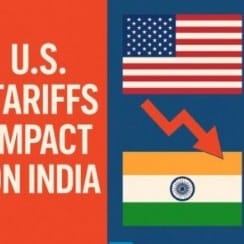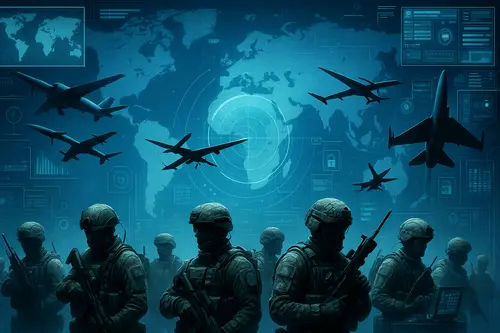
When India was trying to make peace with the earlier imposition of 25% tariff by USA, but then Trump decided to break that peace into pieces by smashing a hefty 25 % additional tariffs on India as a penalty for trading oils with Russia. Affecting almost two-thirds of India’s trade with the United States. The tariffs will impact India’s exporters and vital industries, but its ramifications run deeper than the economy.
Why are tariffs significant for India’s foreign and trade relations in a wider geopolitical context?
For New Delhi, the U.S. tariffs represent a geopolitical conundrum: how can India manage its relationship with the evergrowing partnership with the United States, while needing to continue meeting its obligations to many nations who have remote relations with Washington?
A critical question remains: Will the U.S. tariffs create a vulnerability in India’s trading relationship with the United States, leading to India moving closer to countries who are critical of the United States such as Russia, Iran, or China?
Impact of US tariffs
After being hit by 25 % tariff and an earlier threat of throwing additional penalty on India for transactions with Russia. India made its clear stance as global power by calling for “Self Reliance” which threw thorns on the Washington’s ego. And as a result, They imposed additional 25% tariff as penalty on India. This impacted India in Following ways:
- Textiles, gems and jewellery are the hardest hit sectors .
- Trade Balance will suffer, as according to Economic survey, USA is one of the few countries with whom India had a trade surplus.
- Indian Migrants as well as american residents in USA will now have to pay higher prices for getting there favourite Indian snacks, Masalas, Indian made clothes and many more.
- Indian Market can be opened for USA’s products with low tariffs to please USA, which can hamper domestic firms. For Example- How apple acquired the Mobile Industry in India. Also, Soft Hegemony of USA will increase further as cultural influences will increase.
- Increased Trade with american products substitutes exporting countries like Mexico, China, Canada, Germany, and Japan.
- The move for Self Reliance can help MSME’s and domestic firms to increase their profits.
Country Level Impact of Tariffs on India’s Relationships
The impact of U.S. tariffs on Indian interests is not limited to trade, but will impact New Delhi’s relationships with important countries which tend to oppose Washington.
(a) Russia
For India, Russia is a long-term defence and energy partner. The increased costs associated with U.S. tariffs as well as limited economic options makes Russian oil and defence supplies more appealing to New Delhi. Accordingly, tariffs may even promote India’s energy cooperation with Russia, isolating itself from U.S. influence.
(b) Iran
U.S. sanctions have limited trade between India and Iran particularly concerning oil. Tariffs could give New Delhi an incentive to move forward on stalled projects such as the Chabahar Port, which is a strategically-located point of access to Central Asia that limits reliance on U.S.-influenced routes. This would allow India to foster regional connectivity, while also enhancing the bilateral relationship with Tehran.
(c) China
India and China are adversaries, especially around their border. However, concern about U.S. protectionism could lead them on relatively the same page when convening together in BRICS and the WTO. But the issue of strategic rivalry undermines how far they can go in cooperation–India seeks common position with China on trade matters while not giving over the equation to Chinese control.
(d) BRICS & the Global South
At the multilateral level, tariffs give India space to frame U.S. tariffs as economic coercion that enhance its position as a leader of the Global South. With tariffs as a backdrop, India could frame itself as a trade policy actor that is fair trade and indicates that a multipolar trade world is possible, which could turn a tariff problem into a forum for diplomatic leadership.
Exploiting Synergies Beyond Bilateralism
Even as U.S. tariffs place stress on India’s trade relationship with Washington, it is equally plausible that the tariffs could compel New Delhi to depend more on multilateral gatherings that united many nations which are often critical of U.S. hegemony. If India is to tilt towards multilateralism, then the country can leverage a greater weight and even collectively represent an economic force equal or superior to the U.S. economy.
- Take for example BRICS +, where Brazil, Russia, India, China, and South Africa are joined by newer members such as Iran, Egypt, United Arab Emirates, and Ethiopia. The BRICS + nations collectively have a nominal GDP of approximately $28–31 trillion (roughly on par with the U.S. economy).
- Using purchasing power parity (PPP) data, BRICS+ totals over 40% of world GDP and over half of the world’s population.
- Russia (GDP = around $2.1 trillion), and Iran (around $450 billion), are not large by comparison to the U.S. individually, but linking them inside broader frameworks such as BRICS, or the Shanghai Cooperation Organisation (SCO), helps to support India’s geopolitical position.
To summarise, the U.S. tariffs may erode India’s bilateral trade gains with the U.S., but the tariffs also act as an incentive for New Delhi to further deepen relationships, with a collective economic front which has the numbers, resources, and respective markets necessary to challenge the U.S.
Strategic Risks for India
While U.S. tariffs might push India closer to countries opposed to Washington, getting there would involve costs. A significant shift away from the U.S. would hamper defence cooperation, where advanced technologies transited in joint projects like the Indo-Pacific strategy could be crucial to their intended national security outcome, and it could inhibit U.S. investments in a diverse economy that includes digital infrastructure and clean energy.
Conversely, an over-dependence on anti-U.S. potential partners, like Russia or Iran, could undermine India’s strategic autonomy. Relying on cheap oil or sunk costs in defence supplies provides temporary comfort, but the potential of subjecting India to either internal politics of these partners or the instability brought on by sanctions or the volatility of their own economies exposes India to unwanted strategic risk.
In short, India must continue to be okay straddling the fence: trying to take advantage of its ties to alternative powers, while also trying to reap the long-term benefits of its relationship with the U.S.
Way Forward for India
For New Delhi, the possible challenge is not to choose between Washington and its critics, but rather to balance the two to act in the best interest of its own country. The most realistic way to do this is with a two-prong process. On one hand, India will negotiate for tariff relief in the U.S. to prevent economic frictions from precluding strategic cooperation.
Like-wise, India would be well-advised to seek to actively diversify export markets and increase selective cooperation with Russia, Iran, and the broader BRICS bloc, to diminish overreliance on one market.
Importantly, India can treat those tariffs not only as a hurdle, but also as an opportunity to rebalance trade and diplomacy. If India comes to prioritize its role in multilateral settings and emphasizes domestic competitiveness, the discomfort of external pressure can be converted into a catalyst for long-term resilience.
Conclusion
The new tariffs in the US may well provide accidental space for India to pursue deeper engagement with other countries that have been historically critical of Washington. However, India is more likely to refuse to swing decisively to any camp, but rather will tactically continue to use its strategic flexibility by working with the US where both parties’ interests coincide, while still engaging with Russia, Iran, BRICS and the Global South more broadly to protect its autonomy.
Ultimately, the outcome will depend on India’s ability to align economic resilience with geopolitical balancing. If things go well, tariffs can convert from a source of apprehension to a means of fostering a diverse and self-reliant India on the world stage.
FAQs on India–US Relations and Tariffs
Q1. Why did the U.S. launch tariffs on Indian exports?
The U.S. imposed a 25% tariff on certain Indian exports to protect domestic industries. Washington says it is addressing trade imbalances, while many feel it is protectionist.
Q2. How will U.S. tariffs affect the Indian economy?
Tariffs will raise the price of Indian goods in the U.S. marketplace, making it more difficult for them to compete. This could hurt Indian sectors such as steel and aluminum, textiles, and auto parts amongst others, as well as impact Indian export earnings.
Q3. Will tariffs bring India closer to nations that are anti-U.S.?
Yes, the tariffs may push India to further engage with countries such as Russia and Iran, and with BRICS as well. However, it is likely India will remain balance and will be cautious about becoming too reliant on one bloc.
Q4. Why is the U.S. involved in India’s defence sector?
The U.S. is one of (if not the) India’s largest defence partners and has combined with India to provide advanced weapons systems, drones, and aircraft. Tariff issues may create some friction, but they are unlikely to derail the progress that the two sides have made, and continue to make, for a robust defence partnership.
Q6. What can India do to mitigate the impact of U.S. tariffs?
India can negotiate tariff relief with Washington, diversify its export markets in Asia, Africa and Europe, and enhance domestic manufacturing to reduce reliance on exports.
Q7. Will tariffs impact the India–US strategic partnership?
In some way, yes, but not in a big way. Tariffs create economic friction, but the strategic partnership is influenced by the common concerns of China, Indo-Pacific security, and the technology partnership.


Good